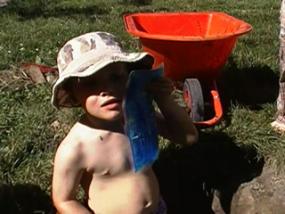Dryden Deserves an Icepack

Dryden is standing in a deep hole, digging with a small shovel; Ewan stands above with a large shovel. Ewan accidentally swipes a bit of mud onto Dryden’s right cheek. Dryden says he needs an ice pack. The teacher asks Ewan to go into the school building to get the ice pack for Dryden. When Ewan demurs, the teacher puts into clear words the value that one needs to help a friend to whom you have brought discomfort, even if the act was an accident. The teacher understands Ewan’s reluctance as he holds the much-coveted large shovel. The teacher promises to reserve the shovel for Ewan’s return. He then complies, retuning with the ice pack in due haste. Dryden is pleased and places the icepack on his left check, more symbolic than functional, given that the insult occurred on his right.
As the digging resumes Dryden is wary of the large shovel coming into the hole again. Ewan says Dryden needs the might of the big shovel to dig him out. The teacher mediates the compromise by first proposing they both use big shovels. She then shifts to the idea that Ewan use a smaller shovel. Both ideas are rejected, the first by Dryden, the second by Ewan. Finally the teacher offers to give them even more choices by suggesting they all go to the shed “to see what our options are.” Both boys agree, and the video ends with Dryden climbing from the hole so they can look together at shovels in the shed. Perhaps they are motivated by this intriguing word, “options.”
We note how the teacher carefully restates each boy’s concerns, requests, rejections of requests and their own counter-suggestions. This restating helps each boy remember his own and the other’s perspective, making it clear what opposites have to be reconciled, while at the same time allowing the boys time to either propose their own methods of reconciliation or agree to one proposed by the teacher. The basic thrust of this encounter can be summarized as, “Let’s think about how we can solve this specified problem.” How would you compare this approach to other approaches you have seen or used when one child’s play interferes with the goals of another child’s play? As teachers, we often wonder when and how to intercede in children’s conflict. What is your opinion about the balance shown in this video between the children’s ideas and the teacher’s ideas?
Runtime: 4 minutes 48 seconds
